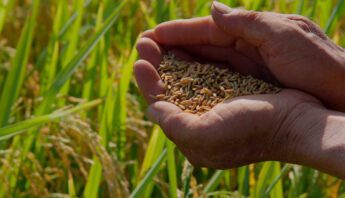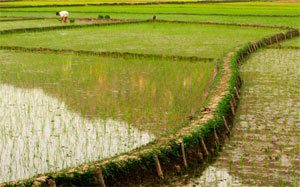Farmers, Indigenous people and rural communities around the world celebrated the International Day for Biological Diversity last week. But casting a long shadow was the news that big funders and new NGOs are teaming up with the pesticide-biotech giant, Syngenta, in a renewed effort to push genetically engineered rice forward in Bangladesh and the Philippines.
Nicknamed “golden rice,” this untested, highly controversial GE crop threatens biodiversity across the region and risks bringing economic and ecological disaster to Asia’s farms.
The Bill and Melinda Gates Foundation has approved $20 million in new monies towards the development of "golden rice." Meanwhile, Helen Keller International (HKI), a New York-based health and nutrition NGO, has also jumped on board.
Speaking from Malaysia, Sarojeni V. Rengam, Executive Director of Pesticide Action Network Asia and the Pacific (PAN AP) called on the donors and scientists involved to wake up and do the right thing:
Golden Rice is really a ‘Trojan horse’; a public relations stunt pulled by the agri-business corporations to garner acceptance of GE crops and food. The whole idea of GE seeds is to make money.
On this International Day for Biological Diversity, we want to send out a strong message to all those supporting the promotion of Golden Rice, especially donor organizations, that their money and efforts would be better spent on restoring natural and agricultural biodiversity rather than destroying it by promoting monoculture plantations and genetically engineered (GE) food crops.
In agreement, hundreds of farmers, scientists, consumers and workers protested in the Philippines. But instead of listening to the thousands of Asian family farmers saying “NO to GMOs,” the International Rice Research Institute (IRRI), which is receiving $10.3 million of the Gates funds, created a promotional video highlighting their delight in having found new partners like HKI.
An economic and ecological disaster
Introducing this GE crop into Asia — the center of diversity for rice — is ecologically, socially and culturally irresponsible. Here’s why:
- Threats to cultural and biological diversity: As a result of the first “Green Revolution,” thousands of traditional and indigenous varieties of rice have been lost across Asia — and with them, cultural knowledge of their management, replaced with a handful of hybrid varieties requiring heavy doses of chemical pesticides and fertilizers. As Slow Food argues, “golden rice” threatens to speed up that process, with the added risk of genetic contamination of Asia’s most precious resource.
- Corporate profit over food sovereignty: Golden rice is a Trojan horse for pushing through GE-friendly biosafety regulations under the guise of humanitarian aid. Once in place, these regulations open the door for the biotech industry to bring in commercial, patented GE crops; USAID and Monsanto accomplished exactly this in Kenya with their sweet potato project. This raises serious equity concerns for both farmers and national governments as they become beholden to biotech giants and lose their rights to save and exchange seed.
- Economic losses: Once GE rice contaminates a country’s rice supply and enters the food chain — which it will — these countries will lose crucial agricultural export markets to Japan and Europe.
- Loss of livelihood: long-term field studies for robustness to climate change and other stressors haven’t been conducted for golden rice, putting the livelihoods of small-scale farmers at risk.
- And anyway, it won’t work: Vitamin A uptake depends on the presence of fats or oils in a person’s diet. There’s no point in pushing “golden rice” when people can’t access or afford the diet they really need to make use of it. Especially when it comes packaged in a monocultural production system that undermines the very dietary diversity that they need. Smarter, cheaper alternatives exist. Most important is recognizing that poverty is the underlying reason for nutritional deficiencies. This can't be solved with a technological fix.
Whose hands in the pot?
Who oversees this ambitious project, which its advocates claim will end the suffering of millions? An elite, so-called “Humanitarian Board” where Syngenta sits — along with the inventors of Golden Rice, Rockefeller Foundation, USAID and public relations and marketing experts, among a handful of others.
Not a single farmer, Indigenous person or even an ecologist, or sociologist to assess the huge political, social, and ecological implications of this massive experiment. And the leader of IRRI’s Golden Rice project is none other than Gerald Barry, previously Director of Research at Monsanto.
Unfortunately, well-meaning NGOs are getting caught up in the GE web. Helen Keller International has done some really top-notch work with home gardens and supplements that has enriched the diets of thousands of families in Asia with micronutrients, including Vitamin A. This is exactly the right sort of thing to be investing resources in.
But earlier this year, HKI decided to jump on the GE bandwagon, agreeing to conduct efficacy studies for IRRI. Even if the engineered rice can be proven “efficacious” in the narrow sense that is meant — able to deliver Vitamin A in a biologically available form — the project still threatens the biological and cultural diversity of an entire region and clearly contradicts the desires of the local people.
HKI, do the right thing and get out. You have too much in the way of good ideas and initiatives to throw your reputation away by doing Monsanto and Syngenta’s dirty work. It’s not too late to extract yourself from this giant genetic misadventure.








